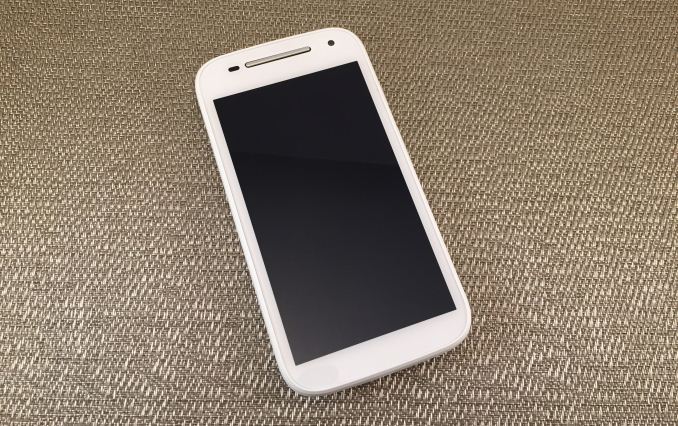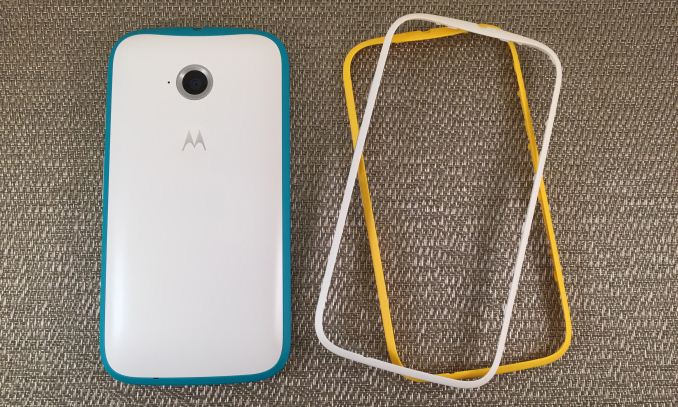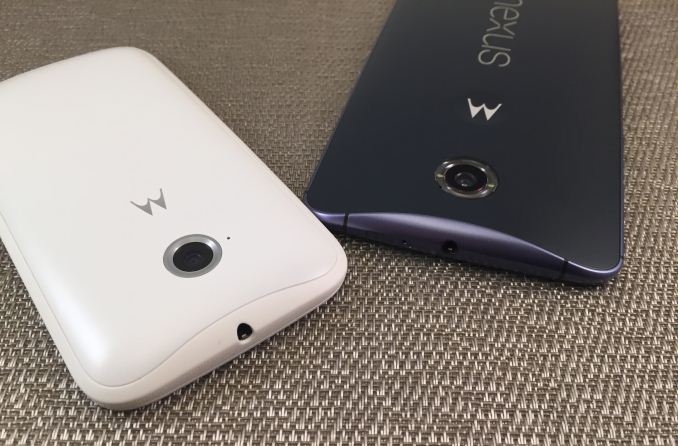The Moto E (2015) Review
by Brandon Chester on April 21, 2015 8:00 AM EST- Posted in
- Smartphones
- Motorola
- Mobile
- Moto E (2015)

During the past couple of years we've seen a dramatic shift in Motorola's strategy for competing in the smartphone market. As one of the earliest producers of Android devices, the company needed to let go of ideas and strategies from years that had since past. Producing exclusive devices for carriers like Verizon was no longer going to work with the iPhone finally freed from exclusivity on AT&T, and Motorola's hardware and software design had begun to show a great deal of age.
That brings us to today, at a point where Motorola has more or less found their new approach to making smartphones. It's a very simple and understandable approach. Consistency across the design of the hardware, consistency across the design of the software, and a yearly line of phones that can easily be divided into budget, mid-range, and flagship categories based on a single letter in their name. This review takes a look at the newest version of Motorola's budget device, the 2015 Moto E. Unfortunately, this year adds a bit of complexity to the simplicity of Motorola's smartphone line. Before getting into that, I've put the general specifications of the new Moto E below, with the original 2014 model as a point of comparison.
| Motorola Moto E (2015) (LTE model XT1527) |
Motorola Moto E (2015) (3G models) |
Motorola Moto E (2014) | |
| SoC | Qualcomm Snapdragon 410 (MSM8916) 4x Cortex A53 @ 1.2GHz Adreno 306 at 400MHz |
Qualcomm Snapdragon 200 (MSM8x10) 4x Cortex A7 @ 1.2GHz Adreno 302 at 400MHz |
Qualcomm Snapdragon 200 (MSM8x10) 2x Cortex A7 @ 1.2GHz Adreno 302 at 400MHz |
| RAM | 1 GB LPDDR3 | 1GB LPDDR2 | |
| NAND | 8GB NAND + microSD | 4GB NAND + microSD | |
| Display | 4.5” 960x540 IPS LCD | 4.3" 960x540 IPS LCD | |
| Network | 2G / 3G / 4G LTE (Qualcomm MDM9x25 UE Category 4 LTE) | 2G / 3G HSPA+ (MDM8x10) | 2G / 3G HSPA+ (MDM8x10) |
| Dimensions | 129.9 x 66.8 x 12.3mm 145g |
124.38 x 64.8 x 12.3mm 142g |
|
| Camera | 5MP (2592 х 1944) Rear Facing w/Auto Focus, F/2.2 aperture VGA (640x480) Front Facing |
5MP (2592 х 1944) Rear Facing w/Fixed Focus | |
| Battery | 2390 mAh (9.08Wh) | 1980 mAh (7.52Wh) | |
| OS | Android 5.0 | Android 4.4.2 | |
| Connectivity | 802.11 b/g/n + BT 4.0, USB2.0, GPS/GNSS | ||
| SIM Size | Micro-SIM | ||
On the cellular side, we have two HSPA models and 1 LTE model of the Moto E. There is an LTE version with UMTS bands targeted at the US market, a 3G-only version for the US market, and a global 3G version. The difference between the US and global 3G bands is the inclusion of the 1700MHz band for T-Mobile support on the US version, and the 900/2100MHz bands on the global version.
Design
Over the past couple of years, Motorola's hardware and software design has undergone some enormous changes. They shifted from producing heavily skinned and modified Android devices to using almost stock Google Android. Their industrial design similarly underwent significant changes, and a new style for their smartphones emerged with the original Moto X in 2013. The flat sides and edges of Motorola's old phones were replaced with continuous curves. This type of design is not only more ergonomic than Motorola's old devices, but also more unique and recognizable. It's very clear from the appearance of a Motorola phone that it is a Motorola phone, even without spotting the depressed logo on the back cover.
The Moto E is no exception to Motorola's industrial design. The back cover has a continuous curve that extends to all corners and meets with the phone's arched sides. The back of the phone has only a center-aligned 5MP camera and Motorola's standard indented logo. Unlike the original Moto E this back cover is no longer removable and customizable with different colors. Since the Moto E is a budget device, it also can't be customized with Motorola's Moto Maker. To add a level of personalization, Motorola has designed the phone so that the band around the edges is removable. Users can purchase a set of red, blue, and yellow bands for $20, and can swap them out with the default white or black bands as they please.
The band being removable creates a potential concern about the usability of the Moto E's buttons, as the part that you press down on is integrated into the bands themselves. During my time with the device I was actually surprised by how tactile the buttons felt and how little they wobbled considering that they were completely separated from the actual button mechanism. They definitely had more of a mushy feeling than the buttons on the Nexus 6, but they were still completely usable and actually better than I expected.
The removable bands also act as a great way to hide many of the ports on the device. Removing the band allows access to the Moto E's MicroSD slot and Micro-SIM port. The SIM slot is spring loaded, but it's so deep that anyone without very long nails will end up having to use a small object to press on the end of the SIM to remove it anyway.
The left side of the device has a tag which is attached internally and has FCC and regulatory information on it, as well as the device's IMEI.
I'm quite happy with the direction Motorola has gone in with regards to design. The basic design of a Motorola phone scales down to $150 devices and all the way up to $700 devices, and on all of them it's visually appealing as well as ergonomic. The material quality definitely takes a step down when you go for those budget devices, with the Moto E sporting a plastic outer band instead of the metal ones on the Moto X and Nexus 6. Despite that, the phone still feels well made and the matte plastic back actually feels just as nice as the one on the Nexus 6. If anything, Motorola might want to worry about their flagship devices not offering enough of an improvement over the very good build quality and materials of their budget offerings.













90 Comments
View All Comments
RealTheXev - Wednesday, April 29, 2015 - link
In my mothers situation.. the fact it can even connect to the wifi is the only thing that matters. lol She will never notice the speed.serendip - Wednesday, April 22, 2015 - link
Is this the first Lenovo-fied Moto device since the acquisition? The specs and price are very underwhelming when similar low-end devices from Lenovo and Xiaomi have 720p displays, more RAM and faster SoCs. 1 GB RAM is a nightmare on Android because apps get killed and have to reload often. That's really annoying for web browsers because the content has to be downloaded again instead of being cached.serendip - Wednesday, April 22, 2015 - link
Xiaomi have really upped their game recently. Flagships have always had weekly MIUI updates but now the budget line (Redmi 1S/2/Note) are also on a weekly schedule for the developer ROM. Better late than never.As for hardware support, that's a big issue because Xiaomi officially doesn't sell outside of China and some APAC countries. You won't have a physical repair depot to turn to if you buy from an online reseller.
spiked_mistborn - Wednesday, April 22, 2015 - link
Great review. You just confirmed what I have been experiencing since I got my Moto E LTE when they first came out. Some of the initial reviews said the screen was dim and poor quality, but I have not found that to be the case, and your test backs that up. Being a recent college grad still looking for work in my field, in addition to a tech enthusiast, this phone was the best option for my budget. It works well enough that I don't mind waiting, for a long time if necessary, for that killer phone that I would actually feel is worth paying several hundred dollars for. Nothing fits that description yet IMO.One thing that I would love to see added to future reviews is network throughput speeds through a VPN. I use OpenVPN all the time for both remote file access/music streaming, and also for security on open WiFi. The OpenVPN connect client recently added support for ARMv8 crypto instructions, so it would be nice to see how everything stacks up when the speed of the internet connection is not a bottleneck. Maybe test over mobile data and WiFi? The WiFi link speed might still be the limiting factor, but if the rest of the soc is working too, such as streaming HD video, the extra efficiency from ARMv8 might be quantifiable. Qualitative differences in the video could show up as well. Maybe a battery rundown test while streaming over the VPN might show some major differences as well?
sonicmerlin - Wednesday, April 22, 2015 - link
Buy a phone used on eBay if you're on a budget. You can get last year's flagships for less than $200sonicmerlin - Wednesday, April 22, 2015 - link
What's the speed difference between Cortex A7 and A53?sasidharkareti - Friday, April 24, 2015 - link
Moto E 2nd generation has good upgrades DDR3, 8GB internal, 4.5 inch IPS, 2300 mAh, Android 5.0, front camera and 3G/4G are most welcomed.The removable bezel is a bit scary everytime it is plucked out. The battery takes a bit loger time to recharge. Besides these two, I love Moto e's performance.
Harry_Wild - Tuesday, April 28, 2015 - link
"802.11 b/g/n + BT 4.0, USB2.0, GPS/GNSS, NFC"It has NFC but no "ac" for the Wi-Fi standard!
Maverick215 - Wednesday, April 29, 2015 - link
Out of curiosity, did you test NFC performance? I ask because the arstechnica review indicates that there is no NFC capability present in this device. Likewise the specs listed on motorola.com say "NFC - No"While I'm hopeful you have some information regarding activating this hidden feature, I'm guessing this was just an error.
Jwraith15 - Sunday, September 27, 2015 - link
Bestbuy now has the Sprint Prepaid LTE VERSION for $39